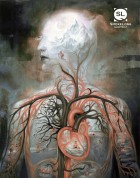One of the things I really appreciate about “Swans” is the way the dark humor weaves its way into the story without becoming too “jokey.” In particular, I’m thinking about the creek and the rather grotesque blisters that appear on the narrator’s skin. Could you describe the role of humor within your work?
Thanks for noticing that. P.G. Wodehouse said that there were two ways to write fiction: to get down into the grit of life, like, say, Ernest Hemingway, or to treat life like a musical comedy, which is something Wodehouse was great at doing. I’m interested in finding the middle way, if there is one. Denis Johnson was a writer who struck that kind of balance, especially in his short fiction—there’s room for laughter despite the pain and the loss. Charles Bukowski saw the absurdity of life’s little tragedies—a broken shoelace or an empty bottle. Kurt Vonnegut had a way of shining some light on dark times, finding the humor there. “So it goes,” he liked to say. Maybe acceptance is the thing.
In part, “Swans” seems to entail a struggle with the trauma of urbanization. The narrator and Sherry witness the destruction of their neighborhood’s surrounding woods, and, as a result, the disappearance of the swan. Did any of the story’s ecological anxieties occur as a conscious choice on your part?
Ideally, setting should help develop the conflict and the drama on an emotional level, even in flash. You begin to see how you can work to develop a place like you do a character. I try to do that. In this story I was thinking about that time period—the early sixties—when the shores along the Chesapeake Bay started to see some development. This was about the same time the interstates were completed and the car started becoming more important, just before the Clean Air Act was passed. Creative pluming solutions like the one in the story were falling out of favor. It was a transitional period when the shores around the Bay went from being a sort of backwater to becoming prime real estate. Most of the areas I’ve lived in have in one way or another exhibited the effects of urbanization. It’s something that tends to crop up in my stories.
Although I didn’t know this when I selected your story, it turns out that you earned your MA from the University of Southern Mississippi, which is where I’m completing my PhD. Could you describe your experience as an MA student at USM?
I spent one rollicking year living in Hattiesburg when downtown was just starting to come back to life, thanks in part to the efforts of some folks taking an interest in things like organic grocery stores and Bloody Mary brunches—stuff the cool kids were doing in other, bigger cities—offering some alternative to the fast food and strip malls that thrived at the other end of town. It was a hopeful time, for me at least, especially when it came to learning how to write fiction. I had just read Frederick Barthelme’s Moon Deluxe, a collection of stories that made me want to live in an apartment complex surrounding a pool and write about amazing everyday things. I was fortunate to have studied with the Brothers Barthelme at the Center for Writers. That was in the Department of Morbid Wit, which I think has since disbanded. Perhaps the spirit still lives on.
How (if at all) might your approach to a flash fiction story like “Swans” differ from your approach to a longer piece of fiction?
Wrapping up a story in a thousand words is a challenge, especially if you like to stretch out and move your legs a bit, maybe pick up some rocks and see what’s under them. If you let characters talk too much or gather a lot of weird stuff around them, you might be surprised at what they do. But that means writing more words. I notice that some characters or settings are riper for development than others, but in flash fiction you don’t have three-to-five acts in which to develop them—you have three-to-five paragraphs. Working within that kind of limitation is a lot like songwriting: You want to get to the hook, tell the story in three verses, hit the bridge and head for that final chorus. I’m a fan of the three-minute popular song, and I like the simplicity of taking maybe two situations that might bounce off each other like call-and-response—adding some third unexpected element that surprises, trying to find the thing that resonates. So it seems that threes figure prominently, maybe even mystically.
You’ve earned a number of advanced degrees, and you’ve published work in a wide selection of lit journals. What’s your next goal as a writer?
I recently started writing a new novel as a way to keep myself from rewriting the one I completed earlier this year, which I’ve been sending to agents with the hope of finding someone who “gets it.” Meanwhile, I’m trying to draw on some of what I learned while writing that one—which was a lot, it turns out—and in the meantime, I’ve come back around to writing shorts, seeing what I can find there. I continue to write and produce music, which seems to offer a bit more immediate gratification artistically. I would also like to return to teaching, which is something I did for several years. I’m still honing the lessons I learned while earning all those advanced degrees and it would be nice to have a use for them. I started a blog where they might live for all eternity.



 The core workshop of SmokeLong Fitness is all in writing, so you can take part from anywhere at anytime. We are excited about creating a supportive, consistent and structured environment for flash writers to work on their craft in a community. We are thrilled and proud to say that our workshop participants have won, placed, or been listed in every major flash competition. Community works.
The core workshop of SmokeLong Fitness is all in writing, so you can take part from anywhere at anytime. We are excited about creating a supportive, consistent and structured environment for flash writers to work on their craft in a community. We are thrilled and proud to say that our workshop participants have won, placed, or been listed in every major flash competition. Community works.